Lifestyle
The Science Behind Food Cravings in the Elderly
Many factors shape food cravings in the elderly, but what hidden influences might be driving these desires? Discover the surprising connections behind them.

Food cravings in the elderly stem from physiological, psychological, and environmental factors. As you age, your cravings often decrease in variety and intensity, especially for sweets and junk food. Women may still crave chocolate more than men, but these urges diminish with hormonal changes. Cognitive decline also affects how you recognize food cues. Emotional connections to comfort foods can trigger cravings linked to nostalgia. Understanding these influences can help you make better dietary choices and manage cravings effectively. If you’re curious about how to navigate these cravings, there’s much more to discover.
Key Takeaways
- Aging leads to a decrease in the number and variety of food cravings, with fewer reported by elderly individuals than younger adults.
- Hormonal and metabolic changes result in diminished cravings for sweets, particularly among elderly women who typically crave chocolate.
- Cognitive decline affects food cue recognition, limiting food variety and influencing cravings in older adults.
- Emotional and environmental factors, including nostalgia and social settings, can trigger specific cravings, often for comfort foods.
- Adopting mindful eating practices and a balanced diet can help manage cravings and improve overall nutritional intake in the elderly.
Understanding Food Cravings

Have you ever wondered how food cravings change as we age? For the elderly, food cravings tend to be fewer in number and variety compared to younger adults.
Curiously, cravings for sweets and junk food decline markedly as you get older. You might notice that elderly individuals often show a lack of response to dietary monotony, meaning the variety or restriction of foods doesn’t strongly influence their cravings.
Comforting dishes like Mushroom Masala may evoke nostalgia and enhance their dining experience. Women in this demographic often report cravings similar to younger individuals but don’t experience an uptick during periods of dietary monotony.
You’ll find that cravings among older adults typically peak in the late afternoon and early evening, indicating specific times of day can influence what they desire to eat.
Psychological factors, like cognitive capacity, might play a role in the reduced food cravings seen in the elderly. Diminished cravings could lead to inadequate dietary intake, affecting overall health.
Understanding these dynamics can help you appreciate how aging impacts food cravings and dietary choices, ensuring you maintain a balanced diet as you navigate these changes.
Age-Related Changes in Cravings

As you age, you might notice a decline in food cravings, which can differ greatly from what younger adults experience. This change may reduce interest in certain flavors and textures, influencing meal choices.
Gender differences also play a role, with elderly women often craving sweets less than before, while men show more consistency in their preferences.
Your cognitive capacity may also influence your response to dietary changes, affecting your overall cravings. For instance, some older adults may find themselves drawn to familiar dishes, such as traditional stuffed pasta, which can evoke nostalgia and comfort.
Decline in Food Cravings
Many elderly individuals experience a noticeable decline in food cravings compared to their younger counterparts. Research shows that elderly participants report markedly fewer cravings, with some elderly men showing almost none during studies. This decline can be attributed to age-related changes in food preferences, leading to a smaller variety of foods that you may crave.
For instance, women’s cravings for sweets, particularly chocolate, often diminish as they age, while men display less variation in their cravings. Additionally, traditional dishes like Red-Braised Pork Belly may not be craved as intensely, reflecting the shift in taste preferences over time.
Young adults typically experience heightened cravings during periods of dietary monotony, but you might find that your response to such changes is minimal. This diminished reaction can be linked to cognitive capacity, which may affect your ability to seek out diverse food options.
If these changes go unaddressed, they could lead to inadequate diets, impacting your overall health.
Awareness of these shifts in food cravings and preferences is essential. By actively seeking out a variety of nutritious foods, you can combat the decline in cravings and maintain a balanced diet, ensuring you meet your dietary needs as you age.
Gender Differences Observed
Gender differences in food cravings among the elderly reveal significant variations in how cravings manifest with age. Research shows that elderly women often report cravings similar to younger adults, but unlike younger individuals, they don’t experience increased cravings during periods of dietary monotony. This suggests a decline in overall cravings as they age.
Notably, cravings for traditional comfort foods, such as Chilaquiles, may also shape preferences. Women consistently exhibit higher cravings for sweets, especially chocolate, compared to men, and this trend remains evident in older age groups.
Notably, women’s cravings for sweets seem to decrease with age, likely influenced by hormonal factors that affect dietary preferences.
On the other hand, elderly men display almost no cravings during studies, highlighting a stark contrast in craving patterns between genders within older populations.
Cognitive Capacity Influence
Cognitive capacity plays a significant role in how food cravings change with age. As you age, your cognitive capacity may decline, affecting how you recognize and respond to food cues. This decline can lead to a reduced craving response in elderly individuals, which might help explain why you experience less variety in food cravings compared to younger adults.
Seasonal dishes, like Nettle and Potato Soup, may not be as readily craved due to these cognitive shifts. Notably, while elderly women often show baseline cravings similar to younger adults, they don’t exhibit an increase in cravings during dietary monotony. This suggests that cognitive processing differences may influence food preferences and choices, limiting your ability to recall past cravings.
Moreover, studies indicate that elderly men report minimal cravings, highlighting how cognitive capacity impacts food desire. Without adequate craving responses, you might struggle to maintain an adequate dietary intake, which can have serious health implications.
Gender Differences in Food Preferences

When you think about food cravings, gender differences play a significant role.
Research shows that women often crave sweets, especially chocolate, more than men, and this trend shifts as they age.
For instance, older women may also find themselves drawn to comforting dishes like turkey soup, which can evoke nostalgic feelings associated with family gatherings.
Understanding these preferences can help you appreciate how hormonal changes and age impact what you crave over time.
Cravings for Sweet Foods
Many elderly individuals experience distinct cravings for sweet foods, and studies show that these cravings often differ between men and women. Research indicates that elderly women tend to exhibit cravings for sweets, particularly chocolate, similar to younger adults. However, these cravings often decline with age, reflecting shifts in food preferences and dietary desires over time.
Additionally, cultural influences can shape these cravings, as seen in regions where traditional sweets, like Brigadeiro, are cherished. In fact, women consistently report higher cravings for sweets compared to men, highlighting notable gender differences in food choices. This difference may stem from hormonal changes that women experience as they age, which can impact their cravings and preferences.
While cravings for sweets are common among younger adults, elderly individuals, particularly men, tend to report fewer cravings overall, suggesting that age-related changes in dietary desires play a significant role.
As you navigate your food choices, it’s important to recognize how these cravings may evolve. Understanding the influences of gender and age on your cravings for sweets can help you make informed decisions about your diet, ensuring it aligns with your health goals while still satisfying your sweet tooth.
Gender-Specific Food Preferences
Understanding gender-specific food preferences can shed light on how your cravings might differ from those of others. Research shows that gender differences play a significant role in food cravings among the elderly. Here are some key points to reflect upon:
- Cravings for sweets: Elderly women often experience stronger cravings for chocolate and sweets compared to elderly men, although these cravings may decline with age. This aligns with the general appeal of sweet treats like Dorayaki (Red Bean Pancake), which are popular among many age groups, including the elderly.
- Dietary monotony: Elderly women report similar baseline cravings as younger adults but show no increase during periods of dietary monotony, suggesting a shift in food preferences over time.
- Hormonal factors: Women’s cravings for sweet foods can be influenced by hormonal changes, especially during life stages like pregnancy, but these influences diminish in older age.
- Nutritional intake: Elderly men typically show minimal cravings, which can impact their nutritional intake and highlight age-related differences in food preferences.
Age-Related Preference Changes
Age-related changes in food preferences highlight significant gender differences that can impact dietary habits among the elderly. You might notice that elderly women often experience stronger cravings for sweet foods, especially chocolate, compared to men. This reflects a key gender difference in food preferences.
As you age, cravings for sweets generally decrease, particularly among older women, likely due to hormonal changes and metabolic alterations affecting taste and desire. Notably, traditional desserts such as Kue Putu may appeal to these cravings due to their sweet coconut and palm sugar flavor, offering a comforting treat.
Elderly individuals report a smaller variety of craved foods than younger adults, who typically express a broader range of food desires. This narrowing of preferences can lead to less diverse diets. You may find that elderly women are more health-conscious, often steering clear of unhealthy foods, a shift that emphasizes their changing priorities as they age.
Furthermore, cravings tend to peak during specific times of the day, particularly in the late afternoon and early evening, which may vary by gender.
Recognizing these age-related changes in food preferences can help you better understand the evolving cravings and dietary choices of the elderly, allowing for more tailored nutritional support.
Psychological Influences on Cravings

While cravings can arise from various sources, psychological influences play an essential role in shaping food desires among the elderly. You might find that your food cravings stem from a mix of emotional and cognitive factors. For instance, cravings for specific comfort foods like squash casserole can evoke warm memories of family gatherings.
Here are four key influences to contemplate:
- Emotional Eating: Food often becomes a source of comfort during stressful times or sadness. This pattern can lead to cravings for specific comfort foods.
- Conditioned Responses: Over time, certain internal and external cues—like the smell of baked goods—can trigger intense cravings linked to past experiences.
- Nostalgic Associations: Cravings may arise from memories tied to particular foods, reminding you of cherished moments or family gatherings.
- Environmental Factors: Social settings and meal timing can intensify cravings. Being around others who are eating can lead to a stronger desire for food.
Understanding these psychological factors can help you develop effective dietary strategies. By becoming aware of your cravings and the emotions behind them, you can make more mindful choices and manage your food desires better.
Neuroanatomy of Food Craving

Food cravings in the elderly are closely linked to specific brain regions that play significant roles in memory, emotion, and awareness. The neuroanatomy involved in these cravings includes the hippocampus, insula, and caudate.
The hippocampus, responsible for emotional responses and memory, suggests that your past experiences with food can heavily influence what you crave today. This connection can make cravings more intense based on your dietary conditions.
The insula plays an important role in interoceptive awareness, helping you recognize hunger and cravings. As you age, this awareness might diminish, complicating your ability to regulate your eating habits effectively.
The caudate, another key player, is involved in reward processing and can further amplify your cravings by associating specific foods with positive feelings.
Together, these brain regions demonstrate how cravings in the elderly can be affected by both physiological and psychological factors. Understanding the neuroanatomy behind food cravings can shed light on why self-regulation in dieting becomes more challenging and highlight the importance of tailored approaches to managing cravings as you age.
Impact of Diet on Cravings

Diet plays a significant role in shaping cravings among the elderly. As you navigate your dietary choices, understanding how these choices impact your cravings is crucial.
Here are four key factors to reflect on:
- Dietary Restrictions: Adhering to strict dietary guidelines can increase cravings, making it essential to find a balance that meets nutritional needs without feeling deprived.
- Dietary Monotony: A limited variety of foods can result in fewer food cravings. Introducing diverse flavors and textures can help combat this monotony and enhance your meals.
- Craving Patterns: Research indicates that cravings peak in the late afternoon and early evening. Strategic meal planning around these times can help you manage cravings more effectively.
- Nutritional Status: Improving your overall nutritional status can reduce the intensity and frequency of cravings. Focus on nutrient-dense foods to support your health.
Therapeutic Approaches to Manage Cravings
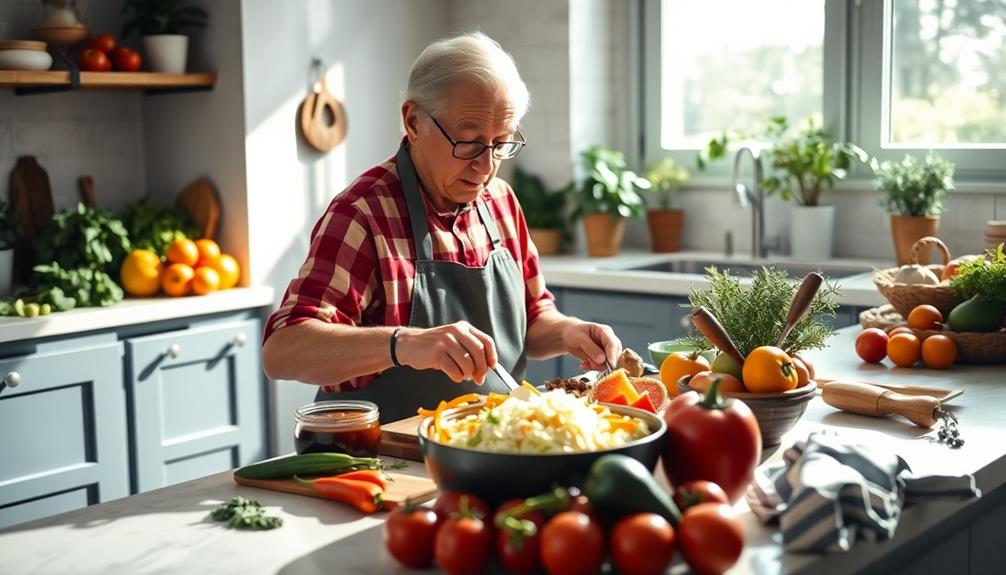
Managing cravings effectively in the elderly requires a multifaceted approach that goes beyond dietary adjustments. One promising strategy is the combination of naltrexone and bupropion, which has shown significant results in reducing cravings and weight among older adults.
Personalized treatment can enhance dietary adherence, especially since many elderly individuals experience fewer cravings yet face dietary restrictions that may impact their well-being.
Understanding the psychological factors behind cravings is essential. Emotional eating patterns often play a role in the elderly, so tailored therapeutic strategies are important.
Behavioral interventions focusing on self-regulation techniques can empower you to manage cravings more effectively. Incorporating mindful eating practices can also help you become more aware of your eating habits, leading to better control over cravings.
Additionally, understanding the neuroanatomy of cravings can inform targeted interventions, ensuring that you’re addressing the root causes of your cravings rather than just the symptoms.
Long-Term Health Goals and Food Choices

Many older adults find that their long-term health goals shape their food choices considerably. As you focus on improving your health, it’s important to align your nutrition with these aspirations.
The elderly population faces increased risks of diabetes, making dietary changes crucial for managing health outcomes.
Here are four strategies to reflect on:
- Prioritize whole plant-based foods: These foods are rich in nutrients and can help manage cravings effectively.
- Aim for healthier options: By choosing low-sugar alternatives, you can reduce the risk of diabetes and enhance your overall well-being.
- Educate yourself about food as medicine: Understanding the long-term benefits of your food choices can empower you to stick to your goals.
- Recognize cravings: Acknowledging your cravings allows you to make conscious decisions, steering you towards better food choices.
Frequently Asked Questions
What Is the Psychological Reason for Food Cravings?
Food cravings often stem from emotional associations and conditioned responses. When you encounter specific food cues, your mind links them to past experiences, triggering desires that can override hunger and lead to indulgence.
What Is the Chemistry Behind Cravings?
Cravings stem from complex chemical interactions in your brain. Neurotransmitters like dopamine and serotonin signal pleasure, while hormonal changes influence appetite. Your body’s chemistry drives the desire for specific foods, often linked to rewards and emotional states.
Why Does My Elderly Mother Only Want to Eat Sweets?
Your elderly mother might crave sweets due to nostalgic memories or emotional comfort. As taste perception changes with age, she may find sugary foods more appealing, using them as a reward or source of joy.
What Vitamin Deficiency Causes Food Cravings?
Vitamin deficiencies, especially in B12, D, and magnesium, can trigger food cravings. When you lack these nutrients, your body signals for high-energy or sweet foods to compensate, making you feel hungrier for specific items.
Conclusion
In understanding food cravings, especially in the elderly, you’ll find that they’re influenced by a mix of biological, psychological, and social factors. Notably, some theories suggest that nostalgia plays a significant role—cravings for specific foods often stem from cherished memories. By acknowledging these cravings and their roots, you can better manage them. Ultimately, balancing these desires with healthy choices can lead to improved well-being, helping you stay on track with your long-term health goals.
Lifestyle
The Unexpected Ways Urban Farming Is Changing Cuisine
Knowing how urban farming influences cuisine reveals surprising connections to flavor, sustainability, and community—discover the transformative impact it has on our plates.

Urban farming's transforming cuisine in surprising ways. You'll find chefs crafting menus based on ultra-fresh, local ingredients. With community-supported agriculture (CSA), you gain access to customizable baskets filled with seasonal produce. This close connection to food enhances flavors and encourages traditional dishes. As you cook with community-grown ingredients, you support local farmers and sustainability. Innovative techniques, like hydroponics, boost productivity and water efficiency, making urban farms essential to food security. Plus, educational workshops deepen your culinary skills. Keep exploring these trends, and you'll discover even more about how urban farming reshapes our plates and communities.
Key Takeaways
- Urban farming initiatives provide chefs access to ultra-fresh, hyper-local ingredients, enhancing menu creativity and sustainability.
- Community-supported agriculture (CSA) allows chefs to adapt dishes based on seasonal crop availability, promoting culinary innovation.
- Hands-on cooking workshops using local produce foster community engagement and deepen understanding of sustainable practices.
- Local dishes featuring nutrient-rich ingredients, like Nettle and Potato Soup, celebrate cultural significance and rich flavors.
- Technology-driven urban farms optimize resource use, producing high yields while minimizing water consumption, reshaping culinary sourcing.
Rise of Local Ingredients

As urban farming initiatives flourish, you'll find that local ingredients are becoming more accessible than ever. With programs like community-supported agriculture (CSA), around 25,000 customizable baskets of fresh produce are distributed weekly from urban farms, making it easier for you to enjoy locally sourced foods.
This surge in urban farming not only enhances food access but also greatly boosts food security in your community. For instance, dishes like Nettle and Potato Soup utilize fresh, local ingredients that are rich in nutrients.
The global vertical farming industry, projected to grow over 25% by 2027, plays an important role in this transformation. Farms such as GoodLeaf's vertical operations yield crops equivalent to traditional farming methods while using 95% less water, ensuring you have access to fresh ingredients year-round.
The pandemic has further fueled interest in local food sources, leading to demand spikes that are three to four times higher in many urban areas.
Culinary Innovation Through Sustainability
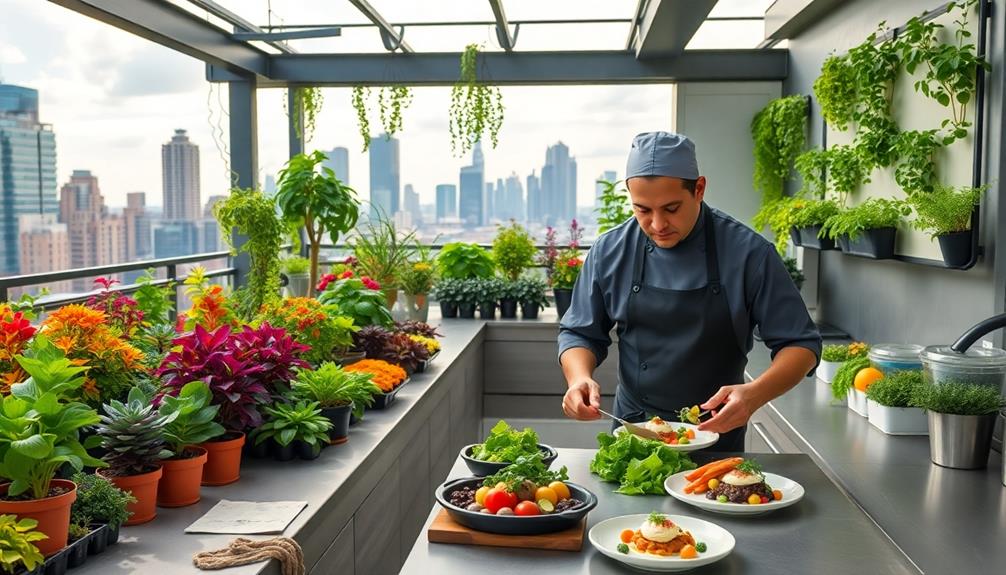
Urban farming is sparking a culinary revolution, giving chefs access to ultra-fresh, hyper-local ingredients that inspire creativity in the kitchen. By collaborating with urban farms, chefs can create dishes that celebrate the vibrant flavors of local food and seasonal produce.
The rise of community-supported agriculture (CSA) programs allows you to tailor your menu based on the crops available each week, fostering culinary innovation and adaptability. This movement mirrors the diversity found in Brazilian Cuisine, where local ingredients and cultural influences create a rich tapestry of flavors.
With vertical farms yielding as much as traditional farms while using 95% less water, sustainable food practices are becoming integral to your culinary approach. Initiatives like Lufa Farms' customizable CSA baskets enable you to source ingredients that highlight the freshness and quality of locally-grown produce, leading to unique and bespoke culinary creations.
As urban farms prioritize biodiversity and organic methods, you're inspired to experiment with heirloom varieties and lesser-known vegetables. This not only enriches local cuisine but also enhances the dining experience, offering your guests diverse flavors that reflect a commitment to environmental responsibility.
Embracing these sustainable practices, you're not just cooking; you're crafting a culinary narrative that celebrates the intersection of innovation and sustainability in modern cuisine.
Community Engagement in Cooking
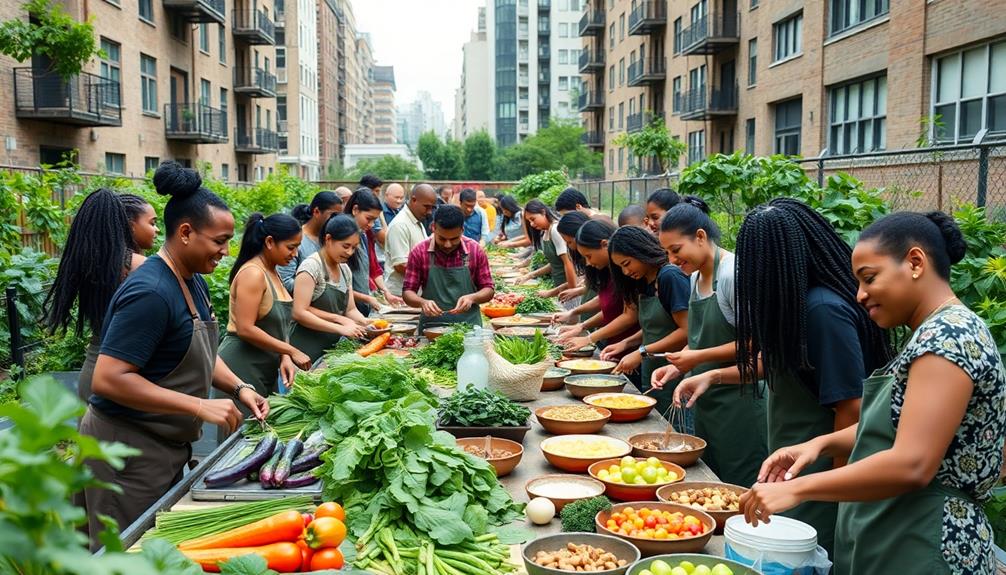
When you engage in cooking with local ingredients, you not only enhance your meals but also support your community's farmers.
Exploring traditional dishes like Muamba De Galinha can introduce you to rich flavors and cultural significance.
Educational cooking workshops empower you to explore new flavors and techniques, making culinary experiences more enjoyable and sustainable.
Local Ingredients Revolution
While the pandemic has reshaped many aspects of our lives, it has also ignited a powerful movement toward local ingredients, connecting communities through cooking. You've likely noticed the surge in urban agriculture initiatives, such as community-supported agriculture (CSA) programs, which have made locally sourced ingredients more accessible than ever.
This shift fosters direct connections between you and the producers, enhancing your appreciation for food sovereignty. As you experiment with local ingredients, you might find inspiration in traditional dishes like Agnolotti, showcasing regional culinary skills that celebrate local flavors.
Organizations like Fresh Roots engage students in hands-on cooking experiences, allowing you to prepare meals using fresh, locally grown produce. This not only boosts food literacy but also promotes culinary diversity as you explore traditional dishes from various cultures.
As urban farms cultivate diverse crops, you can discover new flavors and ingredients that reflect community heritage.
Moreover, GoodLeaf's vertical farms are transforming local restaurant menus, encouraging chefs to feature high-yield crops like baby kale and microgreens.
Educational Cooking Workshops
Connecting communities through cooking doesn't stop at sourcing local ingredients; it extends into hands-on educational cooking workshops that bring people together. These workshops often emphasize the use of locally grown produce, allowing you to engage directly with urban farms like Fresh Roots in Vancouver. Here, you can learn to prepare meals from seed to plate, gaining invaluable skills along the way.
Participants might even explore how to incorporate unique dishes like Dorayaki (Red Bean Pancake) into their cooking repertoire, showcasing the versatility of local ingredients.
By participating in these cooking workshops, you enhance your food literacy, understanding the nutritional benefits of fresh ingredients. This knowledge fosters a deeper connection with local food systems and encourages healthier eating habits within your community.
Many urban farms partner with local schools to host classes, teaching students to cook dishes with vegetables harvested from their own community gardens, enriching their understanding of the agricultural system.
Programs like GoodLeaf's seminars also inspire young farmers by merging cooking education with modern agricultural practices. These initiatives are often part of community-supported agriculture (CSA) programs, helping you maximize the use of your weekly CSA baskets.
This not only promotes creative cooking techniques but also reduces food waste, making cooking workshops a crucial component of community engagement in urban farming.
Education and Food Literacy

Urban farming initiatives offer you the chance to cultivate food knowledge while engaging with your community.
By exploring diverse culinary traditions, such as the rich flavors of Mushroom Masala, you can deepen your understanding of the ingredients and techniques involved in preparing meals.
Through hands-on learning experiences, you can connect with local food sources and understand sustainable practices.
These educational programs empower you to make informed choices about healthy eating and nutrition.
Cultivating Food Knowledge
Cultivating food knowledge is crucial for fostering a more sustainable and equitable food system. Urban farming initiatives like Fresh Roots in Vancouver are leading the charge by educating children about agriculture from seed to market. These programs emphasize food literacy, helping combat food insecurity while instilling a sense of responsibility toward food sourcing.
By introducing students to diverse cuisines, such as Ethiopian dishes like Yeselata and Yekolo, they learn to appreciate the variety of fresh produce available to them. Hands-on learning experiences engage students in understanding the entire food production process, deepening their connection to fresh produce.
Educational field trips at Lufa Farms teach students about natural pest control methods, highlighting the link between sustainable practices and effective food systems. GoodLeaf also plays a critical role by collaborating with schools to promote innovative growing methods through seminars.
This not only enhances students' knowledge of technology's role in modern agriculture but also empowers communities of color with crucial food knowledge. Through these initiatives, urban farming is transforming how individuals perceive and interact with their food sources.
Community Engagement Initiatives
Community engagement initiatives are transforming the way you and your neighbors interact with food and agriculture. By fostering food literacy, these programs empower underserved communities and promote a deeper understanding of where your food comes from. For instance, Fresh Roots in Vancouver has successfully educated kids about agriculture, providing around 70,000 meals to families in need during the pandemic. Urban farmers are at the forefront of these efforts, illustrating the significance of growing food sustainably.
Here's a glimpse at the impact of community engagement initiatives:
| Initiative | Focus Area |
|---|---|
| Fresh Roots | Education and food literacy |
| Lufa Farms | Natural pest control methods |
| GoodLeaf | Technology in farming |
| Community-Supported Ag. | Direct consumer-producer link |
| Urban Farming | Empowering youth and communities |
These initiatives emphasize community-supported agriculture (CSA) programs, enhancing access to fresh food and building direct relationships between you and local food producers. As you engage with these projects, you gain valuable insights into sustainable practices while supporting your local economy. This hands-on approach not only enriches your knowledge but also strengthens your community ties.
Hands-On Learning Experiences
Through hands-on learning experiences, you can gain a deeper appreciation for food and agriculture. Programs like Fresh Roots in Vancouver teach kids about cultivating food from seed to market, linking them directly to the meals they help prepare. This initiative has provided around 70,000 meals to families during the pandemic, addressing food insecurity while enhancing food literacy.
Engaging with local cuisine, such as tamales, allows participants to understand traditional food practices and the importance of local ingredients in their meals.
Field trips at Lufa Farms introduce students to natural pest control, emphasizing sustainable methods that promote healthy food choices. GoodLeaf's seminars engage young farmers with innovative growing techniques, inspiring creative thinking about food sourcing.
Meanwhile, Acta Non Verba in Oakland empowers youth through urban gardens, fostering community and belonging while they learn to cultivate fresh produce.
These hands-on experiences aren't just about growing food; they're about cultivating knowledge. As urban farming initiatives flourish, they play an essential role in teaching communities about healthy eating and sustainable practices.
You'll discover the importance of local food systems, and you'll likely feel more connected to the food you eat. Embracing these experiences can greatly improve your food literacy and, ultimately, your relationship with food.
Technology's Role in Urban Farming

Innovative technologies are transforming urban farming, making it more efficient and sustainable than ever before. For instance, Lufa Farms employs closed-loop hydroponic systems that recycle an impressive 90% of the water used, drastically cutting down on resource consumption.
GoodLeaf's vertical farms showcase how stacked trays can yield the equivalent of a 1.2-acre farm while using 95% less water, highlighting the efficiency of indoor agriculture. Additionally, urban farming can enhance food diversity by incorporating local ingredients, such as those used in traditional dishes like Kue Putu, which utilizes fresh coconut and palm sugar.
Robotics also plays an essential role in modern urban farming. Custom-made robots assist with plant care and production processes, boosting efficiency and lowering labor costs. This tech-driven approach not only enhances productivity but also guarantees fresh produce reaches consumers faster, positively impacting the food supply chain.
The global vertical farming industry is on the rise, projected to grow over 25% by 2027, reflecting a growing interest in sustainable, technology-driven solutions for food production in urban spaces.
Indoor farms, shielded from climate disruptions, utilize advanced air handling systems that recycle over 10,000 liters of water daily, reinforcing sustainability. With these innovations, urban farming is set to redefine how we grow and consume food, paving the way for a more resilient culinary future.
Impact on Food Security

Food security is a pressing issue, and urban farming is stepping up to meet this challenge. As you might know, over 23.5 million people in the U.S. live in food deserts, where access to fresh produce is limited. Urban farming initiatives are essential for addressing these systemic disparities, bringing healthy food options directly to marginalized communities.
For instance, the incorporation of local food sources, such as those inspired by Thai street food, not only enhances food security but also empowers residents to take control of their food systems. By cultivating local food sources, urban farms not only enhance food security but also empower residents to take control of their food systems.
During the pandemic, community-supported agriculture (CSA) programs gained traction, offering direct access to locally grown food. This connection between consumers and producers strengthens communities while alleviating food insecurity.
Additionally, the global vertical farming market is expected to grow considerably, indicating a shift toward local food production that reduces reliance on traditional farming regions.
Urban farms can produce yields comparable to traditional farms, all while using up to 95% less water, especially in vertical setups. This sustainable approach is essential for tackling food security challenges in urban areas.
Ultimately, urban farming plays a critical role in ensuring everyone has access to fresh, nutritious food.
Frequently Asked Questions
How Is Urban Farming Influencing Food Production?
Urban farming's revolutionizing food production by increasing local access to fresh ingredients. You're seeing diverse crops flourish in cities, cutting transportation costs and promoting sustainability. This shift fosters community engagement and enhances food sovereignty in urban environments.
What Are the Negative Effects of Urban Farming?
Did you know over 30% of urban farms face soil contamination issues? Urban farming's negative effects include gentrification, limited water access, food mirages, and climate challenges, complicating food security and community dynamics in your neighborhood.
Will Urban Agriculture Change the Food System in Cities Around the World?
Yes, urban agriculture will transform food systems in cities worldwide. You'll see increased access to fresh produce, reduced food miles, and strengthened local economies, ultimately fostering healthier communities and more sustainable practices in food production.
What Are the Effects of Urbanization on Farming?
Urbanization's reshaped farming by increasing demand for local produce, pushing you towards innovative methods like vertical farming. It's also highlighted food deserts, prompting you to seek sustainable solutions that enhance food access and self-sufficiency.
Conclusion
In a world where culinary landscapes are evolving faster than you can say "farm-to-table," urban farming isn't just a trend—it's a revolution. By embracing local ingredients and fostering community connections, you're not just changing your plate; you're reshaping the very fabric of cuisine. Just like the Industrial Revolution transformed industries, urban farming is redefining how we think about food, sustainability, and togetherness. So, roll up your sleeves and join the movement—it's time to cultivate a tastier future!
Lifestyle
Why Some People Experience ‘Picky Eating’ in Adulthood
Some adults struggle with picky eating due to genetics and past experiences, but understanding these factors can lead to transformative changes in their eating habits.

You might experience picky eating in adulthood due to a blend of genetic, psychological, and environmental factors. Sensory sensitivities can make you averse to certain tastes and textures, while past negative food experiences may lead to food neophobia—a fear of trying new foods. Your eating habits can also be shaped by family influences and limited exposure to diverse cuisines during childhood. Anxiety surrounding food choices can complicate the experience, particularly in social situations. Understanding these factors and how they interact can help improve your relationship with food, and there's more to explore on how to make changes.
Key Takeaways
- Genetic predispositions, such as variations in taste receptor genes, can heighten sensitivity to certain flavors, contributing to picky eating in adulthood.
- Past negative food experiences create psychological barriers, making adults reluctant to try new foods and reinforcing selective eating habits.
- Sensory sensitivity to textures and tastes often leads to strong aversions, influencing food choices throughout adulthood.
- Limited exposure to diverse cuisines in childhood can hinder flavor appreciation, resulting in persistent picky eating behaviors into adulthood.
- Social anxiety during meals can exacerbate picky eating tendencies, as adults may feel pressured to conform to eating norms.
Understanding Picky Eating

Picky eating often stems from a complex mix of genetic, psychological, and environmental factors. You might find that your selective food preferences persist from childhood into adulthood, often driven by food neophobia—the fear of trying new foods. This aversion can be tied to psychological factors, like anxiety or negative experiences with certain dishes, making you more cautious about what you eat.
Additionally, exposure to diverse cuisines, such as the rich flavors found in Brazilian cuisine, can help expand your palate and encourage exploration of new dishes.
Your sensory sensitivity also plays a significant role. If you're particularly sensitive to certain textures or tastes, you're likely to avoid foods that feel slippery or taste bitter, leading to a restricted diet.
Environmental influences, such as the eating habits of your family or cultural norms, shape these preferences as well. If you grew up in a household that favored specific comfort foods, you may have developed a lasting attachment to those familiar flavors.
Understanding these various influences is essential. Recognizing how they intertwine can help you make sense of your picky eating tendencies and encourage you to explore new food options at your own pace.
Embracing gradual changes can lead to a more varied and enjoyable eating experience in the long run.
Genetic and Environmental Factors
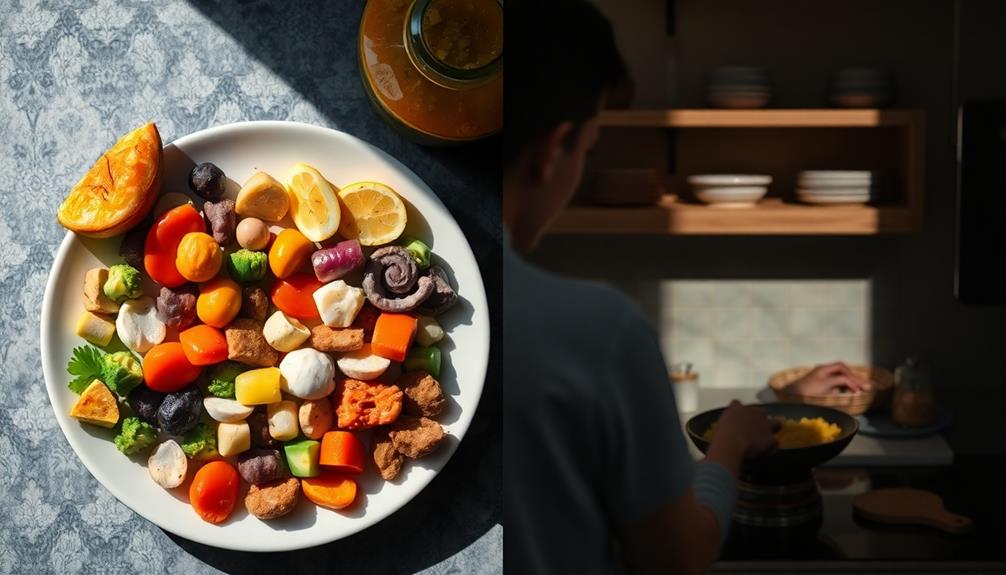
Understanding the genetic and environmental factors influencing your food preferences can illuminate why you might hesitate to try new dishes. Picky eaters often have genetic predispositions, including variations in taste receptor genes that lead to food neophobia—the fear of trying unfamiliar foods. This can heighten sensitivity to bitter flavors and make certain textures off-putting.
For instance, individuals who've been exposed to a narrow range of flavors may find it particularly challenging to appreciate diverse cuisines, such as the rich blend of spices found in Mushroom Masala. Your family upbringing plays an essential role in shaping your eating habits. Early exposure to a variety of foods can enhance your willingness to experiment with new flavors.
Additionally, various environmental factors contribute to your choices:
- Accessibility to diverse food options
- Cultural norms surrounding food
- Societal expectations about what's considered acceptable
- Peer influences on dining experiences
These elements collectively determine the food landscape you navigate as an adult. If your environment lacks variety or encourages limited choices, it can reinforce picky eating behaviors.
Understanding these influences helps you appreciate why certain foods might feel intimidating and why broadening your palate might be a challenge. Recognizing these factors is the first step towards overcoming food aversions and embracing new culinary experiences.
Psychological Aspects of Picky Eating

When it comes to your food choices, anxiety can play a significant role in what you're willing to eat.
If you find yourself feeling overwhelmed by certain textures or smells, sensory processing differences might be at play.
For instance, dishes such as Muamba De Galinha from Angola, with their rich flavors and textures, could be particularly challenging for someone with picky eating tendencies.
Understanding these psychological aspects can help you address your picky eating habits more effectively.
Anxiety and Food Choices
Eating can be a source of anxiety for many adults, particularly for those who struggle with selective food preferences. If you identify as a picky eater, you might find that your food choices often trigger feelings of psychological distress and social anxiety during meals. This can lead to embarrassment and avoidance of social eating situations.
Research shows that picky eaters tend to score higher on anxiety measures compared to their non-picky peers, which highlights a significant connection between anxiety and selective eating. Certain foods, such as those with complex textures or unfamiliar flavors, may intensify this anxiety, making it essential to understand personal food preferences. Exploring traditional dishes, like Dorayaki (Red Bean Pancake), might provide a comforting way to ease into new tastes without overwhelming oneself.
Consider these factors that might contribute to your anxiety around food:
- Heightened sensitivity to tastes, smells, and textures.
- Past negative food experiences that create psychological barriers.
- A desire to assert control in overwhelming social settings.
- Food neophobia, or the fear of trying new foods.
These elements can create a cycle where anxiety perpetuates picky eating behaviors. Understanding these connections can help you navigate your food choices with greater awareness, making it easier to tackle the underlying anxiety that often accompanies picky eating.
Sensory Processing Differences
Many adults who struggle with picky eating also experience sensory processing differences that amplify their food preferences. These differences often result in heightened sensitivity to tastes, smells, and textures, making certain foods, especially those with strong flavors or unusual textures, more likely to be rejected.
For instance, if you've got texture sensitivity, you might avoid slippery foods like eggs or gelatinous items, finding them unpalatable. In Ethiopian cuisine, dishes like Yekolo (Roasted Barley) offer unique textures that might be challenging for those with such sensitivities.
Additionally, picky eaters often have a strong aversion to bitter and sour flavors, which can stem from genetic variations affecting taste receptor genes. This aversion can lead to food neophobia, a fear of trying new foods, often fueled by past negative experiences, like choking or allergic reactions.
When confronted with unfamiliar dishes, you might feel anxious or emotionally distressed, reinforcing selective eating behaviors.
Developmental Influences

Your eating habits today may be shaped by a mix of genetic factors, childhood experiences, and cultural influences.
For instance, exposure to diverse flavors and textures, such as those found in dishes like Red-Braised Pork Belly, can play a significant role in developing a more varied palate.
If you grew up with a limited variety of foods or faced sensory sensitivities, it's likely those patterns have followed you into adulthood.
Understanding these developmental influences can help you navigate your picky eating tendencies more effectively.
Genetic Factors Impacting Preferences
Picky eating often stems from a complex interplay of genetic factors that considerably shape our food preferences. Your genetic predisposition can considerably influence how you perceive and enjoy different flavors.
Research shows that variations in taste receptor genes are linked to taste sensitivity, especially regarding bitter flavors, which can lead to food neophobia—the fear of trying new foods. This genetic basis can affect both children and adults. For instance, those who are sensitive to certain tastes may find it challenging to enjoy traditional dishes like Kue Putu (Bamboo Rice Cake) or Dadar Gulung (Pandan Crepe), which offer unique flavor profiles that might be off-putting.
Consider these key aspects of how genetics impact your food preferences:
- Taste Sensitivity: Your sensitivity to certain tastes, particularly bitterness, can drive you away from certain foods.
- Food Neophobia: Genetic factors may instill a reluctance to try unfamiliar foods, making you hesitant in social dining situations.
- Sensory Processing: Heightened sensitivity to tastes and textures can make certain foods unpalatable.
- Heritability: The heritability of appetitive traits suggests that picky eating can persist throughout life, influencing your dietary choices as an adult.
Understanding these genetic influences can help you navigate your picky eating tendencies and potentially expand your palate.
Childhood Experiences and Habits
Childhood experiences play a significant role in shaping your eating habits as an adult. Many adults with picky eating habits started as picky children, indicating that early food preferences often carry over into adulthood.
If you were exposed to a variety of foods during your childhood, you're more likely to develop a willingness to try new dishes later on. For instance, being introduced to diverse ingredients like heirloom beans or fresh herbs could expand your palate. Conversely, a limited food environment can solidify restrictive eating patterns.
Family influence is essential in this development. Children often mirror the eating behaviors of their family members, which can reinforce picky eating habits. If your family favored certain foods or avoided others, those preferences likely became your own.
Additionally, sensitivity to the texture of food plays a key role in your eating habits. For instance, if you'd an aversion to gelatinous or slippery foods as a child, it's possible that this sensitivity continued into adulthood, narrowing your food choices.
Lastly, the evolutionary caution against unfamiliar foods might still impact your food preferences today. This instinctive behavior served as a survival mechanism, ensuring that you approached new foods with caution.
Understanding these childhood experiences can help you address and possibly reshape your picky eating habits.
Environmental and Cultural Influences
How do environmental and cultural influences shape your eating habits? Your cultural background plays a significant role in determining what foods you find acceptable or appealing. The societal norms you grow up with affect your willingness to try new dishes.
For example, traditional dishes like Vegetable Salad might shape your view on fresh produce and healthy eating. Early exposure to various foods during childhood sets the stage for your future preferences, as positive experiences with diverse flavors can lead to greater openness later on.
Consider these factors that contribute to your eating habits:
- Cultural background: Shapes your perceptions of what's considered normal or desirable in food.
- Early exposure: A diverse diet in childhood can foster a more adventurous palate as an adult.
- Family eating habits: You often mirror the food choices of your parents or caregivers, which can reinforce picky eating patterns.
- Media representation: Advertising and portrayals of food can influence your aversions and preferences, aligning them with cultural ideals.
Social Anxiety and Eating

At social gatherings, the pressure to fit in can make eating a particularly stressful experience for those who are picky eaters. The presence of social anxiety can heighten your discomfort, leaving you feeling embarrassed about your food choices.
In environments like cocktail parties or business lunches, you might find yourself overwhelmed by the anxiety surrounding meals, which could even lead you to avoid these situations altogether. For example, bringing along familiar snacks or dishes, like a festive Graveyard Taco Dip, can ease your tension and spark conversations around food.
Many picky eaters, like you, often carry preferred snacks to social events. This reliance on familiar foods helps mitigate anxiety and provides a sense of security. Studies reveal that picky eaters report higher levels of social eating anxiety, resulting in enjoyment impairment during meals.
As you navigate social situations, the pressure to conform to eating norms can exacerbate your anxiety, making you reluctant to try new foods in group settings.
In these moments, it's common to feel the weight of judgment from others, increasing your distress. Understanding how social anxiety intertwines with picky eating can help you find strategies to cope, making social gatherings a bit more manageable and enjoyable.
Characteristics of Picky Eaters

Many picky eaters share distinct characteristics that shape their dining experiences and preferences. Understanding these traits can help you relate to or identify with the challenges they face. Here are some common characteristics of picky eaters:
- Strong aversion to bitter and sour foods: Many reject vegetables and mixed dishes due to these flavors.
- Preference for familiar comfort foods: You might find that fries and grilled cheese are staples in your diet, overshadowing more diverse culinary options.
- Texture sensitivity: If you avoid slippery textures, like those in eggs or gelatinous foods, you're not alone. This sensitivity plays a significant role in your food choices.
- Anxiety during social meals: Feeling embarrassed about your food preferences can lead you to avoid certain social settings.
These traits can contribute to avoidant/restrictive food intake disorder and result in limited food intake.
Picky eaters often report less enjoyment of eating overall and may view themselves as unhealthy due to their limited dietary variety.
Acknowledging these characteristics is the first step in understanding picky eating in adulthood.
Strategies for Change

Transforming your eating habits can feel intimidating, but with the right strategies, you can gradually expand your palate. Here are some effective approaches to help you on this journey:
| Strategy | Description | Benefits |
|---|---|---|
| Gradual Exposure | Introduce one new food alongside your favorites. | Reduces anxiety over new foods. |
| Positive Reinforcement | Reward yourself for trying new foods. | Encourages experimentation. |
| Modify Cooking Methods | Try roasting or grilling to enhance flavors. | Makes new foods more appealing. |
| Non-Threatening Environment | Share cooking experiences with supportive individuals. | Improves mealtime experiences. |
| Coping Strategies | Use tips from professionals to deal with aversions. | Expands dietary variety. |
Seeking Professional Support

Seeking professional support can be a game changer for adults dealing with picky eating. By consulting with experts, you can gain valuable insights and tailored strategies to help you navigate your food preferences.
Here's how professional support can make a difference:
- Nutritionists can provide personalized advice for gradually introducing new foods into your diet.
- Occupational therapy can assist in overcoming sensory challenges, such as texture aversions or gag reflexes, making it easier to try new things.
- Supportive therapy can help you address the emotional aspects of picky eating, including managing anxiety related to your food choices.
- Specialists can guide you in using systematic desensitization, a therapeutic approach that gradually introduces new foods, allowing you to expand your palate comfortably.
Tracking your progress and setting small, achievable goals with the help of professionals can also motivate you to improve your relationship with food.
Embracing this support can lead to a more varied diet and greater enjoyment of meals, ultimately enhancing your overall well-being.
Don't hesitate to reach out—your journey toward a more adventurous eating experience can start today!
Recognizing Serious Concerns

Recognizing the signs of serious concerns related to picky eating is vital for your health. If you identify as a picky eater, it's important to be aware that extreme cases may indicate Avoidant Restrictive Food Intake Disorder (ARFID). This mental health condition often leads to significant weight loss and nutritional deficiencies, putting your overall well-being at risk.
If you find yourself feeling distressed about food choices or experience anxiety or depression tied to your eating habits, these psychological issues could be warning signs. Research shows that adult picky eaters report higher levels of eating-related clinical impairment compared to moderate eaters. This can lead to long-term consequences, such as heart and bone problems due to inadequate nutrient intake.
Take a moment to evaluate your eating behaviors. Are you avoiding entire food groups? Have you noticed significant weight loss? If so, it might be time to seek professional help.
Awareness of these potential health concerns can make a difference in your journey toward better eating habits and improved mental health. Don't hesitate to reach out if you're struggling; recognizing these serious concerns is the first step toward recovery.
Frequently Asked Questions
What Is the Root Cause of Picky Eating?
Picky eating often roots in genetic factors, sensory sensitivities, and past experiences. You might also find your preferences shaped by family and cultural influences, which can create lasting habits that persist into adulthood.
What Is the Psychology Behind Picky Eaters?
The psychology behind picky eaters often involves heightened sensory sensitivities, anxiety about new foods, and negative past experiences. These factors create strong food preferences, making it challenging for you to try unfamiliar dishes.
Why Did I Suddenly Become a Picky Eater?
You might feel like you've suddenly entered a food war zone! Changes in taste, heightened anxiety, or past experiences could be triggering your pickiness. Reflect on your recent emotional and environmental shifts for deeper insights.
How Do You Treat an Adult Picky Eater?
To treat an adult picky eater, gradually introduce new foods alongside familiar ones. Use positive reinforcement, create a relaxed mealtime atmosphere, and consider professional guidance to address any underlying anxieties or texture sensitivities.
Conclusion
In understanding picky eating, it's clear that a mix of genetics, environment, and psychology plays a role. If you find yourself avoiding certain foods, like Sarah, who struggles to eat vegetables due to a childhood aversion, know you're not alone. By exploring strategies for change and possibly seeking professional support, you can expand your palate and improve your relationship with food. Remember, it's never too late to embrace new flavors and experiences!
Lifestyle
The Psychology of Food Plating in Home Cooking
The psychology of food plating can transform your home cooking experience—discover how visual appeal impacts flavor perception and meal enjoyment.

Plating your food isn't just about looks; it's a key factor in how you enjoy your meal. A well-plated dish can make flavors pop, elevating your overall dining experience. Bright colors and contrasting textures not only grab your attention but also stimulate your appetite. The choice of dinnerware and the arrangement of food play significant roles in your taste perception. Even the lighting and music you choose can enhance or diminish your meal's enjoyment. Curious about how these elements interact? There's so much more to discover that can transform your home cooking into a beautiful experience.
Key Takeaways
- Food plating enhances meal enjoyment by creating anticipation and appreciation for flavors through visual engagement and aesthetics.
- Color choices in plating significantly impact flavor perception and emotional responses, influencing overall dining experiences.
- Effective use of lighting and ambiance can enhance flavor intensity and enjoyment, shaping how food is perceived.
- Music plays a crucial role in dining atmosphere, affecting taste perception and enhancing the overall sensory experience.
- Mindful and artistic plating techniques can transform everyday meals into extraordinary dining experiences, fostering creativity and connection.
The Art of Food Plating

When you plate food, you're not just serving a meal; you're creating an experience that can elevate the enjoyment of your dish. The art of food plating plays an essential role in how diners perceive the taste and overall quality of their meals. For instance, a beautifully plated dish like Red-Braised Pork Belly can enhance the anticipation and appreciation of its rich flavors.
Studies reveal that artistic salads can be rated up to 29% tastier than their unarranged counterparts, highlighting the powerful psychology behind aesthetics.
By utilizing contrasting colors and textures, you can create a vibrant presentation that draws attention and stimulates appetite. Incorporating negative space in your plates helps avoid clutter, allowing your food to shine as the centerpiece. Techniques like using plating rings for uniform shapes or squeeze bottles for sauces can transform your home-cooked meals into restaurant-level presentations.
The psychology of plating encourages mindful eating habits. When food looks appealing, you're more likely to savor each bite, enhancing your overall meal satisfaction.
How Plating Affects Taste

Many people don't realize just how much plating can influence their perception of taste. When you present food, you're not just serving a meal; you're engaging your diner's senses.
Research shows that visual processing engages 50% of the brain, meaning the way you plate your dish can considerably alter how it's perceived. Plating is artistic, and studies have demonstrated that beautifully arranged salads are rated 29% tastier than their less appealing counterparts.
Curiously, the rich culinary traditions from around the world, such as Asian Cuisine, can inspire unique plating styles that enhance the dining experience.
Using the right dinnerware also matters. For example, white plates tend to amplify sweet flavors, while darker, angular plates enhance savory tastes. This simple choice can change the taste experience before the first bite is taken.
Additionally, messy plating can diminish flavor perception, while a well-arranged presentation elevates the overall enjoyment of the meal.
Colors and Their Impact

Plating goes beyond mere aesthetics; it greatly impacts how you perceive flavors, and color plays an essential role in that effect. The colors you choose can enhance your dining experience and influence flavor perception in profound ways. For instance, round, white plates can elevate sweetness, while black, angular plates amplify savory notes. Bright colors foster excitement and stimulate appetite, whereas dull hues might detract from enjoyment.
Here's a quick guide to how different colors may affect your dining experience:
| Color | Impact on Flavor Perception | Emotional Response |
|---|---|---|
| Red | Enhances warmth and appetite | Passion, excitement |
| Green | Evokes associations with veggies | Freshness, healthiness |
| Yellow | Stimulates excitement | Happiness, energy |
When you use colors consciously, you not only make your dishes visually appealing but also shape the emotions and expectations tied to your meal. For example, serving desserts on green plates might subconsciously signal that they're less appealing. By considering colors in your plating, you can greatly elevate the overall dining experience.
Lighting and Ambiance
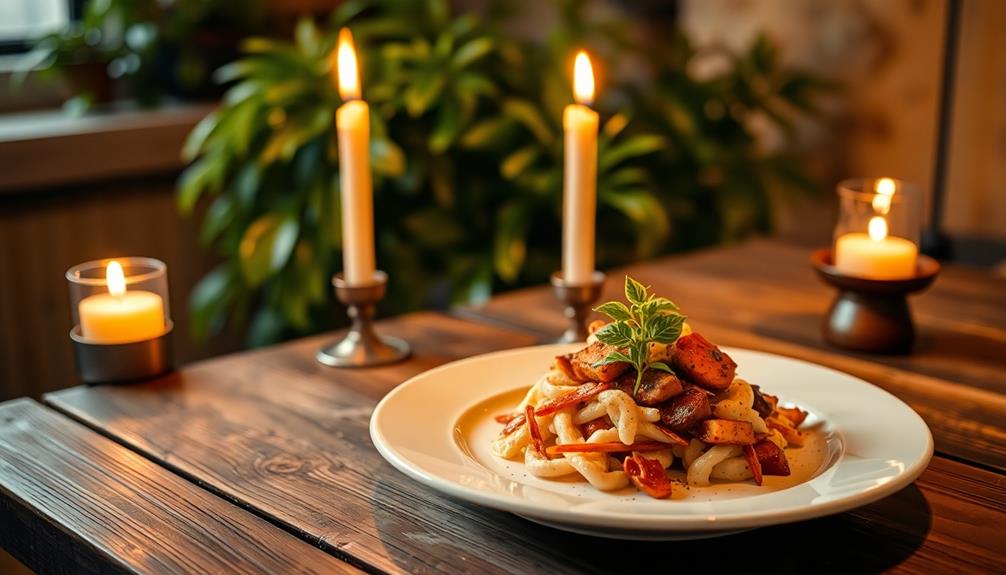
When you consider the lighting in your dining space, think about how it shapes your perception of food.
Bright lights can amplify bold flavors, while softer tones enhance delicate dishes.
For instance, the vibrant colors of a dish like Caldeirada can be further accentuated under warm lighting, creating a mouthwatering visual appeal.
The right ambiance not only invites guests in but also plays an essential role in their overall enjoyment of the meal.
Lighting Effects on Perception
Lighting dramatically shapes how you perceive food, impacting everything from flavor intensity to overall enjoyment. The right lighting can enhance your dining experience or detract from it.
For example, when serving dishes like Nettle and Potato Soup, bright lighting can help highlight the vibrant green color, making the dish appear more appetizing.
Here are some key lighting effects to evaluate:
- Bright lighting: Boosts the perception of strong flavors, making it perfect for rich dishes.
- Dim light: Creates a cozy ambiance, enhancing subtle flavors in lighter meals.
- Colored lighting: Affects food perception; red lighting can amplify the fruitiness in wines, while blue lighting might reduce your appetite.
- Consistent lighting: Helps maintain a cohesive dining experience, while abrupt changes can distract and alter your perception of the food.
- Warm vs. cool lighting: Influences the mood; warm light can create a welcoming environment, enhancing overall enjoyment.
Color Temperature Impact
The temperature of color in your dining space can dramatically influence your meal experience. Bright light, for instance, enhances strong flavors and encourages you to enjoy your food more. This type of lighting sets the stage for vibrant meals, such as a beautifully plated Dorayaki (Red Bean Pancake), making them appear more appealing.
On the other hand, dim lighting creates a cozy atmosphere, perfect for savoring subtle flavors while allowing you to relax.
Think about how colored lighting can affect your dining experience. Red lighting might amplify the fruitiness of wine, making it taste even better. Conversely, blue lighting could reduce your food intake by altering your visual expectations and appetite.
The overall ambiance you create with color temperature plays a vital role in how enjoyable your meal is. Warmer lights often make food look more appetizing, enhancing your overall dining experience.
Creating Inviting Atmosphere
An inviting atmosphere transforms an ordinary meal into an extraordinary experience. The right lighting and ambiance not only enhance the aesthetics of your dish but also greatly boost your overall enjoyment.
For instance, when hosting Halloween-themed gatherings, consider serving dishes like Graveyard Taco Dip that not only taste great but also create a visual impact.
Here's how you can create that perfect setting:
- Adjust the lighting: Use dim lighting for subtle flavors and brighter lights for bold tastes.
- Incorporate colored lights: Consider red tones to amplify fruitiness or blue to subtly reduce portions.
- Arrange your space: Guarantee comfort in your dining area, as this influences your meal's enjoyment.
- Control the temperature: A comfortable room temperature is essential for a pleasurable dining experience.
- Maintain consistency: Cohesive lighting and decor elevate the sensory experience, making your meal feel special.
Music's Role in Dining

You mightn't realize it, but the music playing while you eat can greatly enhance your dining experience.
Pairing your meal, such as a rich Mushroom Masala, with carefully chosen melodies can create a harmonious atmosphere that complements the flavors.
Different sound frequencies can amplify the flavors you're tasting, making sweet dishes even sweeter and savory ones more satisfying.
Music Enhances Flavor Perception
Music's powerful influence on flavor perception can transform an ordinary meal into a multisensory experience. When you pair your meals with the right tunes, you can elevate the enjoyment of sweet foods and savory dishes alike.
Higher-pitched sounds, like chimes, boost the perceived sweetness of your favorite desserts, while lower-pitched music enhances savoriness in savory meals. This interplay can completely change how you experience your food, making dishes like Turkey Soup even more comforting and enjoyable.
Here are some ways music can enhance your dining experience:
- Higher frequencies can make sweet foods taste even better.
- Classical music can enhance wine enjoyment during tastings.
- Faster tempos can speed up your eating, altering flavor perception.
- Rhythm and tempo influence how you savor your meal.
- Emotional responses to music can amplify sensory experiences.
Sound Frequencies and Taste
Sound frequencies play an essential role in shaping our taste experiences, influencing how we perceive flavors during meals. Research shows that higher-pitched sounds enhance sweet flavors, making desserts and fruits even more enjoyable. For instance, the delicate sweetness of a dessert like Agnolotti can be elevated by the right soundscape.
So, the next time you indulge in a sweet treat, consider the soundtrack playing in the background; it could heighten your enjoyment.
On the flip side, savory foods benefit from lower-pitched sounds. When you savor a rich stew or a hearty pasta dish, the deep tones can elevate your dining experience, making those flavors more pronounced. This connection between sound and taste is a powerful tool in both home and restaurant settings.
Studies have even found that classical music can enhance your appreciation of wine, demonstrating how the right sound frequencies can transform a simple meal into a culinary delight.
Many restaurants curate playlists to align with specific food types, ensuring that sound complements flavor. By understanding the influence of sound frequencies on taste, you can enhance your own dining experiences at home, creating an atmosphere that elevates both sweet and savory dishes alike.
Creating Ambiance With Music
An inviting atmosphere can transform a meal into a memorable experience, and the right music plays a pivotal role in achieving that ambiance. The psychological effects of music can greatly influence your dining experience, shaping your mood and altering your perception of flavors.
For instance, serving a rustic dish like Horiatiko Psomi alongside your meal can enhance the overall sensory experience. Here are some ways to enhance your meal with music:
- Choose Higher-Pitched Sounds: These can enhance sweetness in dishes.
- Opt for Lower-Pitched Tunes: They complement savory flavors beautifully.
- Experiment with Genres: Different styles can elevate the overall dining experience.
- Incorporate Classical Music: This can enhance wine enjoyment and food pairings.
- Create a Cohesive Playlist: Thoughtful selections reinforce the sensory experience.
Creating a Multi-Sensory Experience

When you plate a dish, you're not just serving food; you're setting the stage for a multi-sensory experience that can transform a meal into a memorable event. The visual appeal of your presentation plays a significant role in how diners perceive and enjoy their meal.
Studies show that beautifully plated food can evoke positive emotions and justify higher pricing, making aesthetic presentation essential.
To enhance the experience, incorporate a variety of colors, textures, and garnishes. This not only adds visual interest but also engages multiple senses, making each bite more exciting. For example, artistic salads are rated 29% tastier than their less appealing counterparts, highlighting the power of a well-plated dish.
Additionally, strategic use of negative space prevents clutter, allowing each component to shine. When you create height and layering in your presentation, you captivate diners and elevate their overall experience.
Techniques for Effective Plating

Effective plating techniques can elevate your dishes from ordinary to extraordinary, transforming how diners perceive their meals. By thoughtfully arranging your food, you can enhance both visual appeal and overall enjoyment.
Here are some essential techniques to take into account:
- Plan and Organize: Choose contrasting colors and arrange components for a vibrant presentation.
- Experiment with Textures: Layer ingredients and create height to add visual interest and balance.
- Incorporate Garnishes: Use fresh herbs or edible flowers to enhance textures and colors while utilizing negative space to avoid clutter.
- Choose Appropriate Dinnerware: Opt for round, white plates for sweet dishes or angular black plates for savory flavors to optimize visual appeal.
- Employ Plating Tools: Use plating rings for uniform shapes, squeeze bottles for sauces, and tweezers for delicate garnishes to achieve precision.
Storytelling Through Presentation
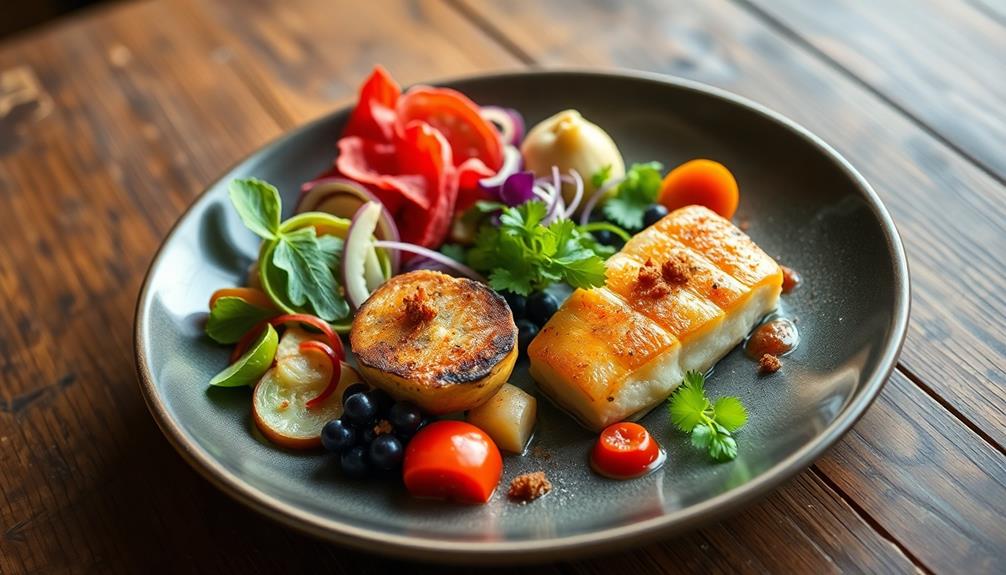
Storytelling through presentation transforms a meal into an experience, allowing chefs to express their creativity and connect with diners on a deeper level. When you plate a dish, you're not just arranging food; you're crafting a narrative. Each ingredient selection and artistic element can evoke emotions and memories, creating an emotional connection that elevates the dining experience.
Research shows that 18% of diners prefer artistic presentation, highlighting how powerful storytelling can be in enhancing customer satisfaction and perceived value. By using seasonal ingredients, for example, you tell the story of the time of year, linking diners to the freshness and origin of their meal.
A beautiful plate not only creates anticipation but also justifies higher pricing, making the meal memorable long after it's finished. Engaging presentation styles, like incorporating whimsical elements or cultural significance, can turn a simple meal into an enchanting storytelling experience that delights diners.
Ultimately, effective food presentation isn't just about aesthetics; it's a chance to share stories, evoke emotions, and forge connections, making every meal a unique narrative that resonates with those who enjoy it.
Enhancing Meals With Atmosphere

The right atmosphere can transform a good meal into an unforgettable experience. When you focus on elements like lighting, color, and sound, you greatly enhance your dining experience.
Here are some tips to create the perfect atmosphere:
- Adjust your lighting: Use bright lighting for bold flavors and softer lighting for subtle tastes.
- Incorporate color psychology: Warm colors can create a welcoming vibe, while cool colors can evoke calmness.
- Choose the right music: Higher-pitched sounds can elevate the perception of sweetness in desserts, adding an auditory layer to your meal.
- Create a cohesive theme: Align your decor, lighting, and music to engage multiple senses consistently.
- Foster positive interactions: Humor and engaging conversations can enhance flavor perception and overall satisfaction.
The Future of Home Dining

As you explore the future of home dining, consider how innovative presentation techniques can transform your meals.
By focusing on artistic plating, you not only enhance the visual appeal but also elevate the entire dining atmosphere.
With the right approach, even a simple meal can feel like a special occasion right at your table.
Innovative Presentation Techniques
While many home cooks focus on flavor, innovative presentation techniques can transform a simple meal into a memorable dining experience. By mastering a few plating techniques, you can enhance the visual appeal of your dishes and encourage mindful eating. Here are some ideas to elevate your home dining:
- Use plating rings to create uniform shapes.
- Experiment with contrasting colors and textures.
- Incorporate height by layering or stacking elements.
- Utilize negative space to avoid clutter.
- Add garnishes for a pop of color and sophistication.
These methods not only make your food look more attractive but also promote a sense of enjoyment and satisfaction during meals.
When you take the time to present your food beautifully, you create a more engaging dining experience that invites appreciation and attention.
Plus, you'll find inspiration in online courses and social media platforms, offering a wealth of resources to refine your skills.
Enhancing Dining Atmosphere
Creating an enchanting dining atmosphere at home can transform an ordinary meal into an extraordinary experience. To achieve this, pay attention to the details that elevate your food and drink presentation.
Start with lighting; bright lights can highlight strong flavors, while soft, dim lighting enhances subtler tastes. Experiment with different lighting options to set the right mood for each meal.
Next, don't underestimate the power of music. Curate playlists that align with your dishes—higher-pitched sounds pair beautifully with sweet foods, while savory dishes thrive on lower-pitched tunes. This thoughtful integration of music can greatly enhance your dining atmosphere.
Lastly, focus on your table setting. Use clean, aesthetically pleasing dinnerware and arrange your food thoughtfully. Engaging in DIY meal preparation and plating not only hones your cooking skills but also makes your meals visually appealing.
When you create an inviting atmosphere with the right lighting, music, and presentation, you turn a simple dinner into a memorable dining experience. Embrace these elements, and watch how your home dining transforms into something truly special.
Frequently Asked Questions
What Is the Psychology of Plates?
The psychology of plates shapes your dining experience. Colors and shapes influence your perception of flavor, making meals more appealing. When you plate food thoughtfully, you enhance enjoyment, encourage consumption, and even affect your mood.
What Is the Nordic Look Technique Plating?
Did you know that 70% of diners judge a meal by its presentation? The Nordic Look technique emphasizes simplicity and natural ingredients, using negative space and earthy tones to highlight freshness and promote visual harmony on your plate.
How Plating Affects One's Perception on Food?
Plating affects your perception of food by influencing how you feel about its taste and quality. When dishes are visually appealing, you're likely to enjoy them more, enhancing your overall dining experience and satisfaction.
What Is the Purpose of Plating in Cooking?
The purpose of plating in cooking is to make your dish visually appealing. When you present food beautifully, it enhances its perceived taste, making your dining experience more enjoyable and inviting for everyone at the table.
Conclusion
In the end, remember that you eat with your eyes first. By focusing on the art of food plating, you can elevate your home dining experience and make every meal feel special. Consider how colors, lighting, and even music can enhance the overall atmosphere. With a few techniques, you can turn simple dishes into culinary masterpieces that tell a story. Embrace the psychology of plating, and you'll find that every meal becomes a celebration.
-

 News4 months ago
News4 months agoYoung Tennis Prodigy Emerges: Merri Kelly Hannity
-

 Lifestyle4 months ago
Lifestyle4 months agoSocial Growth: How to Grow Your Home Decor Instagram Following!
-

 Vetted4 months ago
Vetted4 months ago15 Best Coastal Home Decor Items to Transform Your Space Into a Seaside Oasis
-

 Vetted4 months ago
Vetted4 months ago15 Best Home Decor Dupes That Look Expensive But Are Budget-Friendly
-

 Lifestyle4 months ago
Lifestyle4 months agoShow Your Love: How to Appreciate Someone's Home Decor in 5 Easy Steps!
-

 Vetted4 months ago
Vetted4 months ago15 Best Fireclay Farmhouse Sinks of 2024 – Style Meets Durability
-

 Lifestyle4 months ago
Lifestyle4 months agoUltimate Guide: How to Arrange Home Decor for a Stunning Look!
-

 Lifestyle4 months ago
Lifestyle4 months agoDIY Window Treatments: How to Install Home Decor Collection Blinds!































